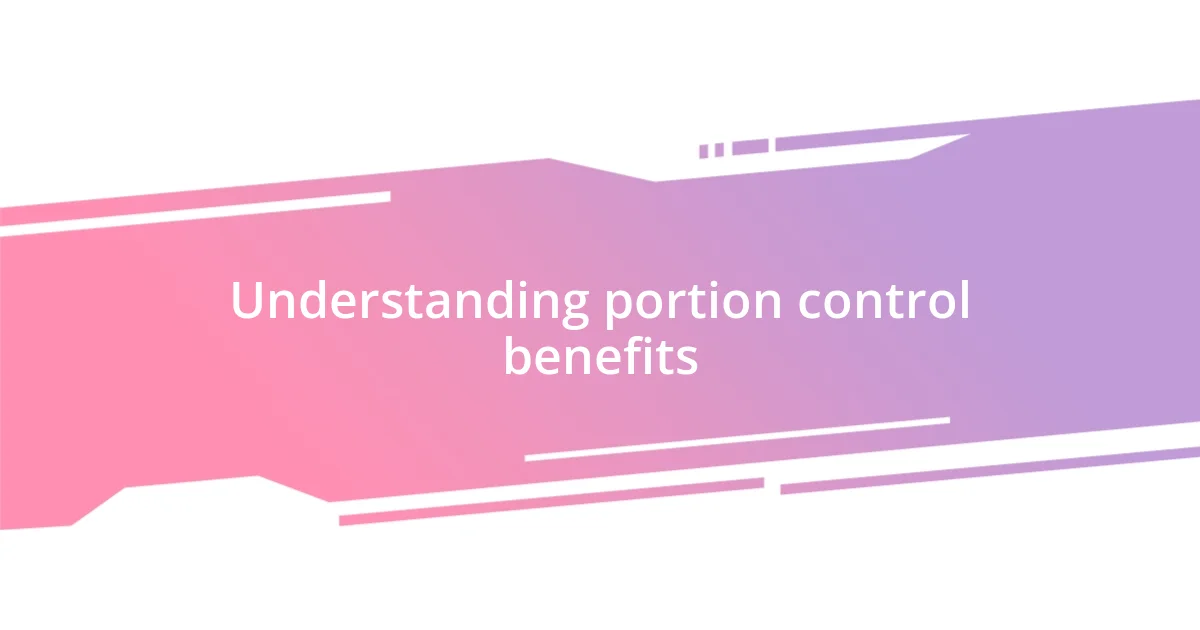Key takeaways:
- Portion control enhances enjoyment of food and helps maintain a healthy weight without guilt.
- Identifying personal portion sizes can be achieved through mindful eating, measuring tools, and visual cues.
- Tracking progress and sharing goals with a friend fosters accountability and reflection on eating habits.

Understanding portion control benefits
One of the most surprising benefits of portion control I’ve experienced is how it transforms my relationship with food. I used to think that eating less meant feeling deprived, but by learning to manage my portions, I discovered the joy in savoring each bite. Have you ever taken a moment to truly appreciate a meal instead of mindlessly consuming it?
Additionally, portion control can help in maintaining a healthy weight without feeling like you’re on a strict diet. I remember a time when I stress-ate during a busy week, and the pounds crept up without me even noticing. By paying attention to my portion sizes, I found that I could enjoy my favorite foods while keeping my body in balance. It’s empowering to know that you can indulge mindfully without overdoing it.
Moreover, practicing portion control allows for flexibility in my eating habits. There are days when I want to indulge a little, and with control, I can do so without guilt. I often ask myself, “How can I make this meal enjoyable yet balanced?” This mindset not only enhances my meals but also encourages a healthier lifestyle overall.

Identifying personal portion sizes
Identifying my personal portion sizes took some time and experimentation. I started by paying close attention to how different amounts of food made me feel—both physically and emotionally. Once, I realized that a single scoop of ice cream was truly satisfying rather than the usual three scoops I’d pour into a bowl, which often left me feeling sluggish and guilty. This revelation illuminated the importance of tuning into my body’s signals rather than being swayed by the size of my bowl.
To help me identify what feels right for me, I use these practical strategies:
- Mindful Eating: I take my time with meals, placing my focus on each bite, which helps me gauge my hunger levels.
- Measuring Tools: I grabbed measuring cups and a kitchen scale to have a clear idea of portion sizes initially. It was surprisingly eye-opening!
- Visual Cues: I use my hand as a guide—like a palm-sized portion of protein or a fist-sized portion for vegetables—to simplify things when I’m in a hurry.
- Food Journaling: Keeping a simple food diary made me more aware of my eating habits and portion choices over time.
- Trial and Error: I experimented with various portion sizes and noticed how they affected my energy and satisfaction. It’s all about finding what works uniquely for me.

Practical tips for meal prepping
Meal prepping has been a game changer for me. When I set aside a couple of hours each week to prepare my meals, I not only save time during busy days but also ensure I stick to my portion control goals. I remember the initial challenge of finding time, but once I established a routine, it felt almost therapeutic. Have you ever felt the satisfaction of seeing neatly organized meals in your fridge? It’s like a mini victory every time I open it!
One practical tip I’ve found helpful is to batch cook. Instead of making just one meal, I prepare several components at once—grains, proteins, and veggies. For instance, on Sundays, I will make a large pot of quinoa, grill some chicken, and roast a variety of colorful vegetables. The key is to keep it simple, focusing on a few versatile ingredients that can be mixed and matched throughout the week. This not only enhances variety but also keeps me from feeling like I’m stuck in a food rut.
Another tip is to invest in clear containers. I use them to portion out my meals visually, and it’s a game-changer in terms of avoiding over-serving. Plus, when I can see the deliciousness packed neatly in front of me, it’s much easier to resist the temptation of grabbing extra snacks. How do you manage your portions during busy weeks? I’ve realized that being proactive in meal prepping sets me up for success instead of relying on takeout or unhealthy options on those tired evenings.
| Tip | Description |
|---|---|
| Batch Cooking | Prepare multiple components at once for easy meal assembly throughout the week. |
| Clear Containers | Use transparent, portion-sized containers to visually manage serving sizes and keep meals appealing. |

Mindful eating techniques for success
Mindful eating has transformed the way I approach my meals. One technique that I find particularly effective is to set a peaceful atmosphere during dining. I dim the lights, put away distractions like my phone, and sometimes even light a candle. This small ritual encourages me to slow down and truly savor each bite, allowing my body to communicate its hunger and fullness cues more clearly. Has anyone else experienced a shift in their eating habits just by changing the environment?
Another technique that has driven success for me is the practice of starting each meal with a moment of gratitude. Taking a second to appreciate the food in front of me and the effort that went into it adds a layer of mindfulness that enhances my connection to my meal. I can’t tell you how many times I’ve been surprised by how much more fulfilling my plate feels after expressing gratitude. It also reminds me to be conscious of what I’m eating and the effect it has on my body.
Finally, I find that portioning my meals on a smaller plate changes the game entirely. Whenever I do this, my brain seems to register that I’m still enjoying a full plate, which helps prevent the urge to keep serving. I remember one particular dinner where I transitioned to a salad plate for my meals, and it felt like a revelation. I left the table feeling satisfied but not overly stuffed. Have you tried this technique? Sometimes the simplest changes can lead to remarkable outcomes.

Tracking progress and staying accountable
Tracking my progress has become a vital part of my journey with portion control. I often find myself jotting down what I eat throughout the day. Initially, I thought it would feel tedious, but documenting my meals has turned into a valuable tool for reflection. Have you ever noticed how writing things down can reveal patterns you weren’t aware of?
To ensure accountability, I’ve started sharing my goals with a close friend. This simple act has created a kind of support network that motivates me to stay on track. What’s interesting is that knowing someone else is aware of my goals makes me take them more seriously. Have you considered discussing your progress with someone? It can make all the difference.
One of my favorite methods for tracking progress is using a food diary app. I’ve tried several, but I always come back to the one that lets me visualize my daily habits. Each week, I take a few minutes to review my intake and reflect on how I felt physically and emotionally. This practice not only helps me gauge my portion sizes but also enhances my awareness of what truly nourishes my body. Remember, it’s not just about the numbers; it’s about how you feel after each meal.














